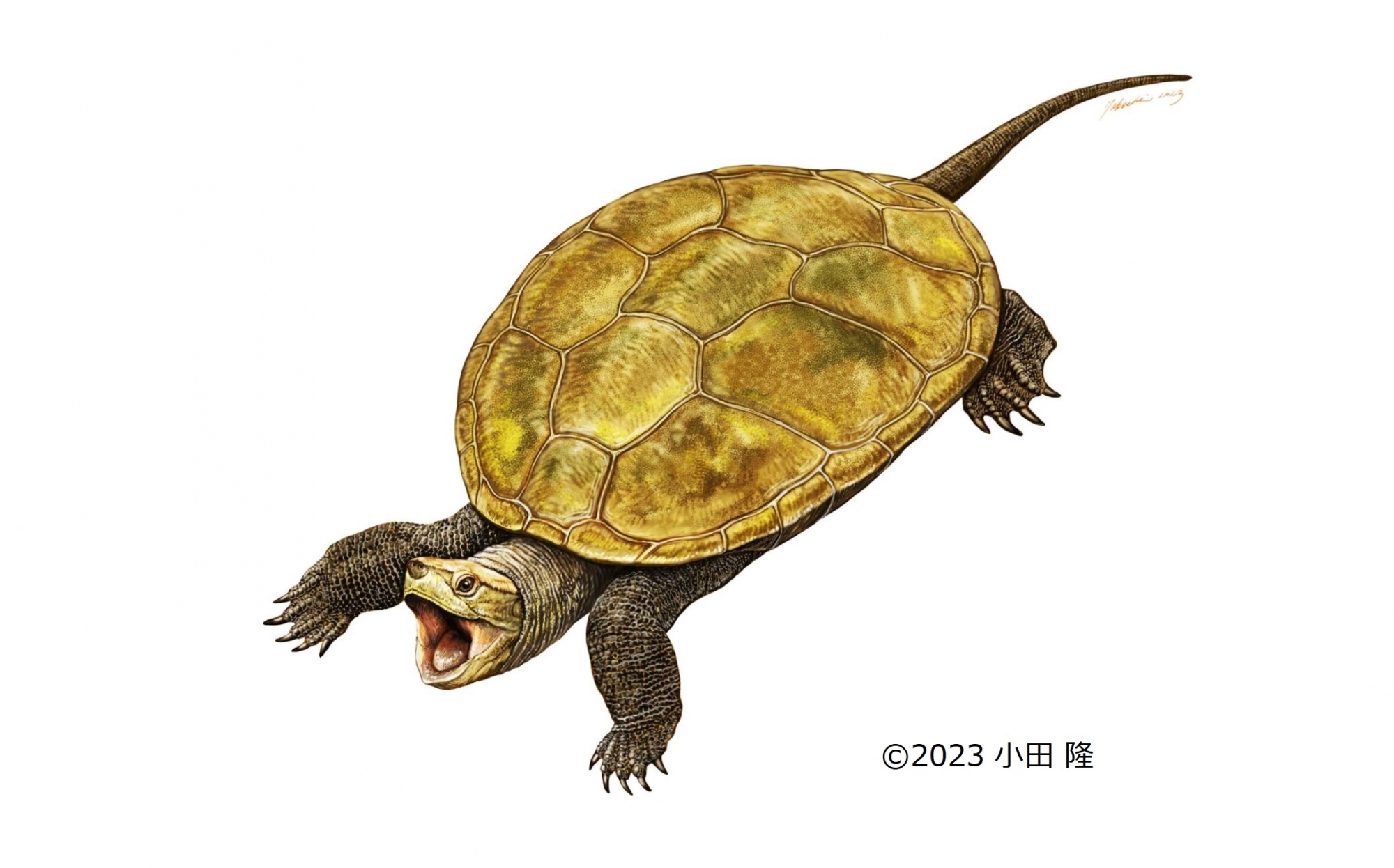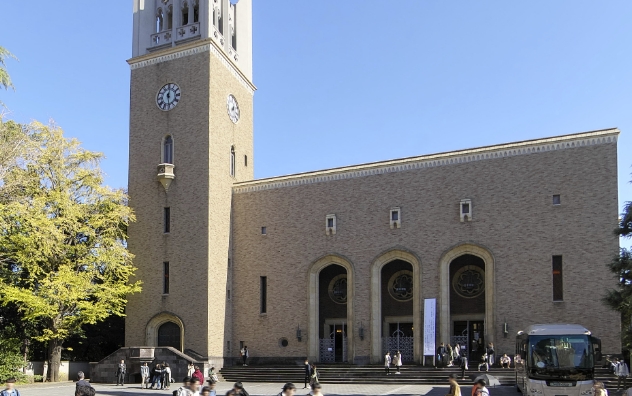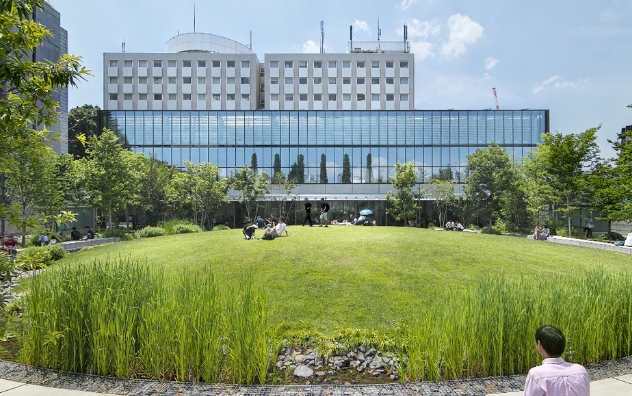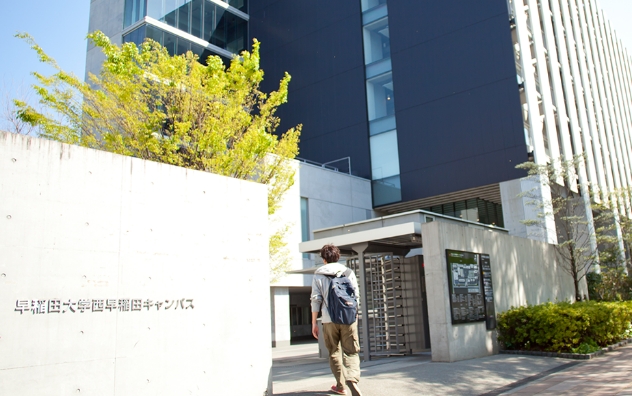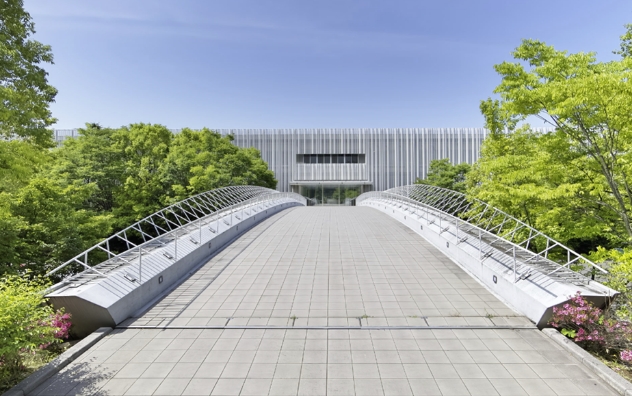Discovery of a new species of turtle in Kuji City, Iwate Prefecture
Mon, Aug 7, 2023-
Tags
Discovery of a new species of turtle in Kuji City, Iwate Prefecture
A new species of turtle “Lindholmemisidae” from the Late Cretaceous period (about 90 million years ago) discovered in Kuji City, Iwate Prefecture
The Kuji Amber Museum (Kuji City, Iwate Prefecture, Director: Hisao Shinden) and Professor Ren Hirayama of the Faculty of International Research and Education, Waseda University, are jointly excavating turtle fossils in Kokuji, Kuji City. A press conference was held at Waseda University (Shinjuku-ku, Tokyo, President: Aiji Tanaka) on Thursday, July 13, 2023, following the discovery of a new species of extinct turtle (Lindholmemisidae). Details of the discovery will be reported at an international conference scheduled at the University of Tokyo in early August.
As of June 2023, 2,955 vertebrate fossils of about 30 species have been discovered in the Tamagawa Formation (formed about 90 million years ago) in Kuji City, Iwate Prefecture, including tooth fossils of large plant-eating dinosaurs (sauropods), the carnivorous dinosaur Tyrannosaurus, and skeletons of turtles and crocodiles. The area is significant for obtaining better knowledge on the species of the dinosaur age (Mesozoic Cretaceous) in Japan.
Places and formations where fossils have been found
The excavation site where a new species of turtle fossil (Lindholmemyidae) was discovered is in Kokuji Town, Kuji City, Iwate Prefecture. The Tamagawa Formation of the Kuji Formation (Late Cretaceous, about 90 million years ago: dating by radioactive materials in volcanic ash) distributed around this area has been excavated by Professor Ren Hirayama and his colleagues since March 2012. So far, about 30 kinds of vertebrate fossils (about 2,800 items) have been discovered, including the teeth of large plant-eating dinosaurs (sauropods), carnivorous dinosaurs (theropods), turtles, crocodiles, colistodera, and sharks.
Additionally, an almost complete shell of the turtle Adkus kohaku (2008), the hip bone of a small plant-eating dinosaur (ornithischians) (2008), part of the wing of a pterosaur (metacarpal bone: 2010), a tooth fossil of the carnivorous dinosaur Tyrannosaurus (2018), and the dorsal spine of the ancient shark Hybodas (2019) have been discovered at the amber mining experience site operated by the Kuji Amber Museum. Fossils of terrestrial vertebrates from the Tamagawa Formation continue to be discovered. The area around the Kuji Amber Museum is a precious place where both amber and dinosaur era fossils are buried, such as pieces of amber weighing up to about 3 kg. It is a rare area in the world fondly referred to as “Kuji, the land of amber and dinosaurs”.
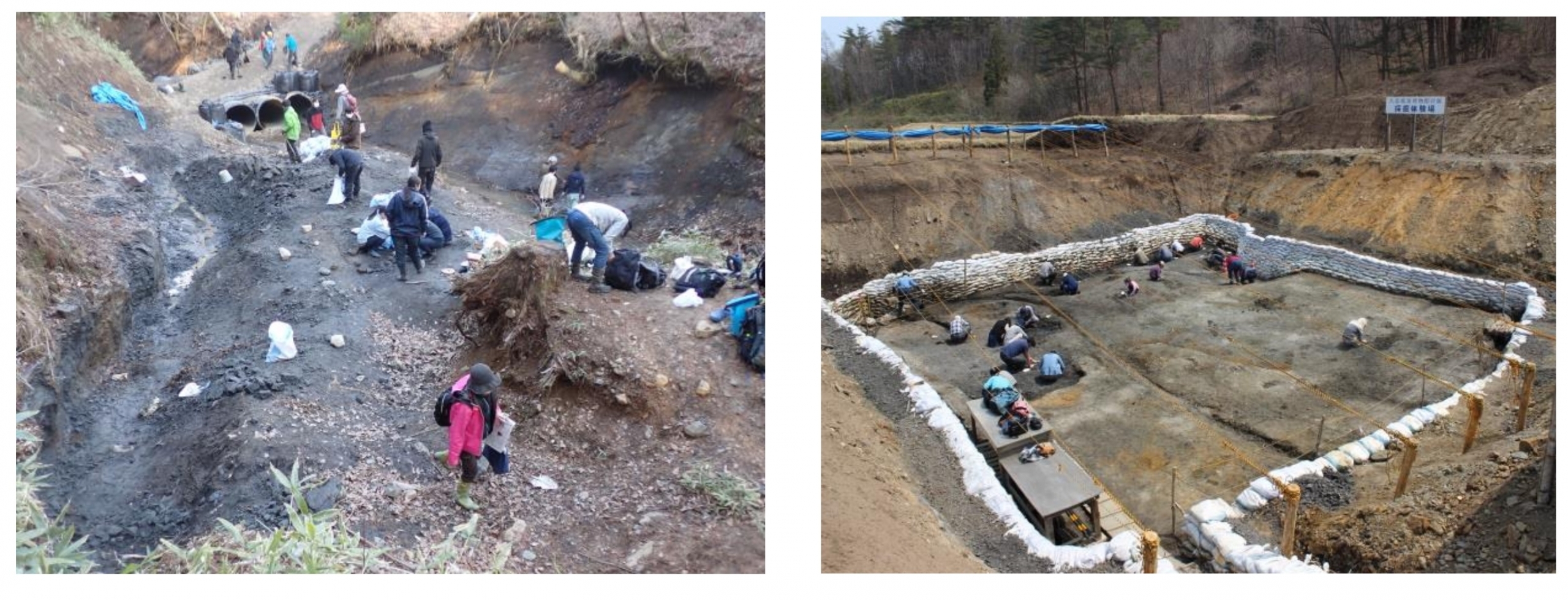 Surveying at the excavation site / The amber mining experience site
Surveying at the excavation site / The amber mining experience site
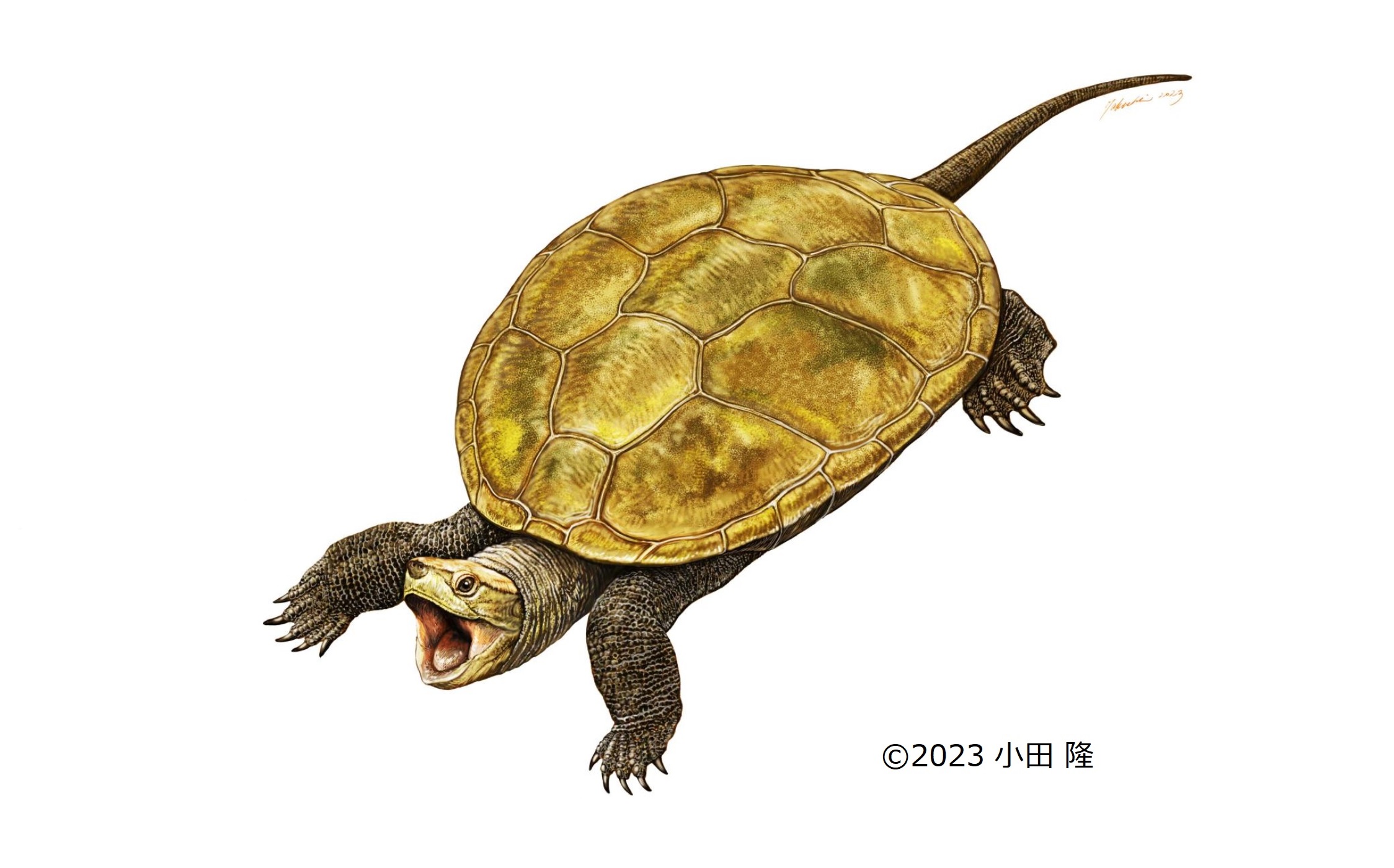
Restoration drawing of a new species of turtle in the Lindholmemys family (produced by Takashi Oda)
Major vertebrate fossils discovered from the Tamagawa Formation of the Kuji Formation
- July 2010: Discovery of pterosaur fossils from the amber mining experience site (press release in July 2011)
- March 2012: Tooth fossils of large plant-eating dinosaurs (sauropods) discovered at the excavation site by Waseda University
- March 2015: Asia’s first “Coristodella” (extinct aquatic reptile) from the late Cretaceous period was presented at an academic conference (press conference was held in Kuji City in July of the same year)
- March 2016: Professor Hirayama’s seminar students discovered Iwate Prefecture’s first carnivorous dinosaur tooth fossil (press release in March of the same year)
- June 2018: High school students discover fossilized teeth of tyrannosaurus from the amber mining experience site (press release in May 2019)
- May 2019: Discovery of the first ancient shark Hybodas from the Late Cretaceous period in Japan by the general public from the amber mining experience site (press release in July 2020)
- April 2021: Press release of the discovery of a new species of turtle (Adkus kohaku )
- July 2022: Press release on the discovery in Kuji of the feeding habits of sauropod dinosaurs
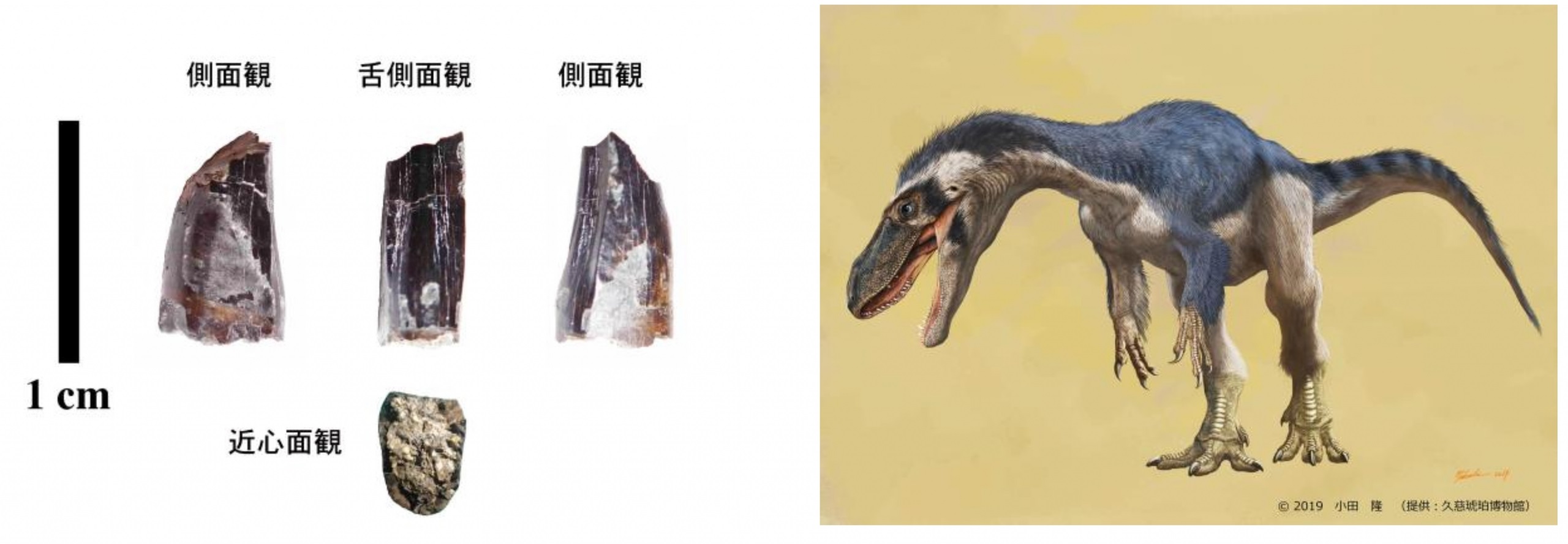
Tyrannosaurus tooth fossil discovered in 2018 and reconstruction image
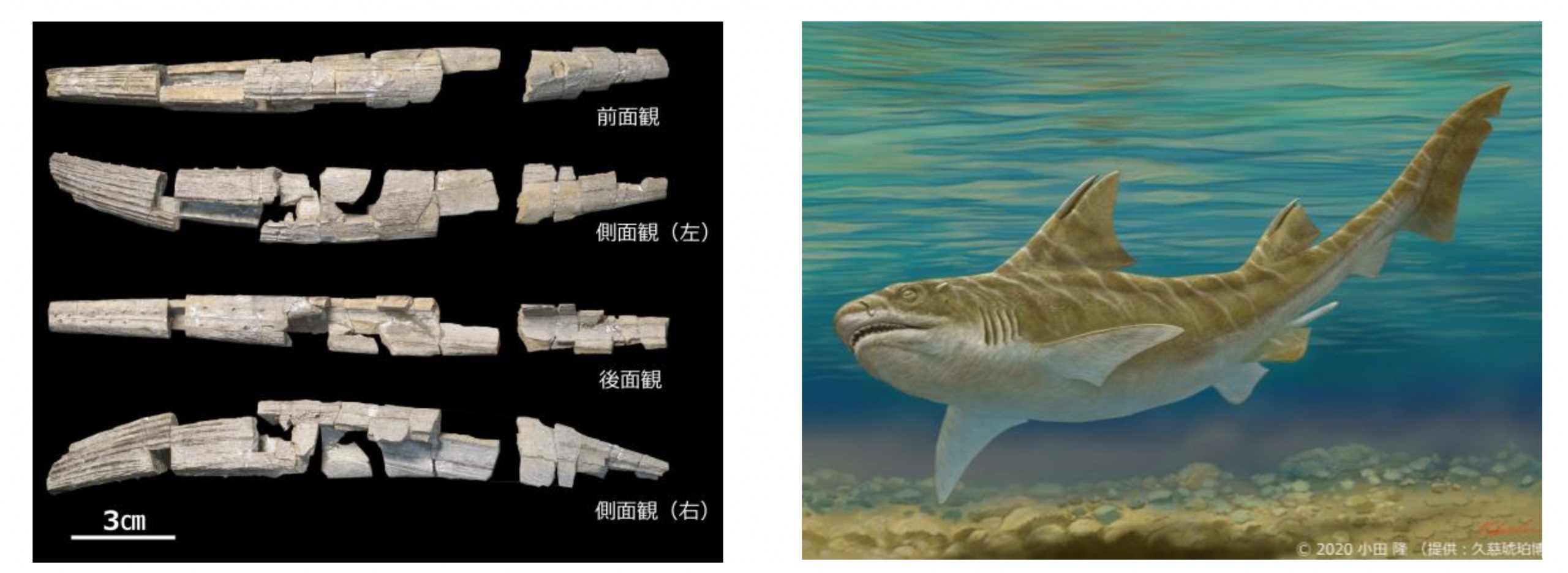
Fossil spines of ancient shark Hibodus discovered in 2019 and reconstruction image
New species of turtle fossil Lindholmemyidae
Discovery location: Excavation site (Kokuji Town, Kuji City, Iwate Prefecture)
Discovery date: March 27, 2023
Discoverer: Tasuku Kubo (8 years old, 2nd grade elementary school student at the time of discovery)
Parts found: Mandibular (registration number OSD 4444: from the Kuji Amber Museum) and 110 additional materials (part of the shell and skull)
Geological formation (geological period): Kuji Formation, Tamagawa Formation (about 90 million years ago: late Cretaceous of the Mesozoic era)
Significance and characteristics of this fossil discovery
About 300 extant species of turtles are known, of which 160 belong to the tortoise family. The family Honjo is a diverse group that includes the pond turtle family (Japanese pond turtle, lacewing turtle, etc.), the European sea turtle family (red turtle, etc.), and the tortoise family (Galapagos giant tortoise, etc.), and is distributed throughout terrestrial areas of the world except Australia and cold regions. Tortoises lived in the late Cretaceous period of the Mesozoic era as a small group called Lindholmemisidae. Eleven genera of this family are known from Asia (China, Mongolia, and Uzbekistan), but except for one genus, only carapaces (hard upper shells) have been discovered.
At the bone bed of the Tamagawa Formation, intensive excavations have been carried out in March and August every year from March 2012 to the present. Discoveries of turtle fossils have been particularly numerous, totaling 1,100 items. Of these, fragmentary shells of small turtles thought to be of the Lindholmemyidae account for more than 100 pieces. Excavations in March 2023 also uncovered additional material on Lindholmemys turtles, but the lower jaw (and carapace) has features not found in other turtles, so it was determined to be a newly discovered species.
Further details
In the Tamagawa Formation in Kuji City, 1,100 turtle fossils have been discovered so far. Adkus kohaku is a large turtle reported as a new species in 2021, reaching a carapace length of up to 60 cm. In addition, the discoveries of similar large turtles of the Trionychidae and Carettochelyidae families have been confirmed. Also, a small turtle fossil shell with a carapace length of less than 25 cm has been confirmed, and it has been determined to be of the Lindholmemyidae family based on the patterns on its shell surface. The Kuji specimen is the first Lindholmemys family to be identified in Japan.
Among turtles, the Lindholmemyidae have the following morphological characteristics:
- The outer side of the abdominal carapace that joins the dorsal carapace is strongly developed and reaches the back of the costal plate.
- The scale grooves (the boundary of the scales covering the carapace) are several times the relative depth and width of other aquatic turtles such as Adax.
- The carapace is up to 30 cm long, which is small for a Cretaceous terrestrial turtle.
- The continuous development of four to three pairs of inferior marginal scales at the border between the ventral and dorsal carapaces distinguishes them as a tortoise family from after the Eocene (the two pairs of anterior and posterior lower marginal scales are discontinuous).
The Lindholmemys family is considered to be the ancestral (or basal) group of the currently most dominant turtle family, the tortoises. Eleven genera of Lindholmemys have been identified from the Late Cretaceous to the Paleogene period (about 90 million to 60 million years ago) in Asia (Mongolia, China, Uzbekistan, etc.), but only carapaces have been discovered except for the Mongolemis from Mongolia. In particular, the details of the lower jaw have been unknown until now.
In the fossil of the lower jaw discovered by Tasuku Kubo in a survey in March this year, it was confirmed that the occlusal surface is narrow in front and expands in the back, a feature not seen in modern turtles. This suggests that early tortoises moved their jaws differently from modern species. In addition, in the shell of the Kuji specimen, the first vertebral scale is very narrow, and the twelfth marginal scale reaches the second upper caudal plate, a feature not found in other turtles in this family. Therefore, the Kuji specimen is considered to be a newly discovered species.
The bone bed of the Tamagawa Formation is about 90 million years old according to radiometric dating of the volcanic ash in between, indicating that the Kuji specimen is the oldest species in the world in this family (also in the Tortoise family). The Kuji specimen is a valuable resource that shows the unknown diversity of the early tortoises and demonstrates that Japan is an important location for exploring the adaptive emission of modern turtles.
The Kuji specimen is the sixth Mesozoic vertebrate fossil reported as a new species from the Tohoku region, following Inai Ryu (Inaisaurus: Triassic period of Miyagi Prefecture), Utatsu ichthyosaur (Triassic period of Miyagi Prefecture), Futaba Suzuki Dragon (Futabasaurus: Late Cretaceous period of Fukushima Prefecture), a species of fish (Ischyrhiza iwakiensis: Late Cretaceous period of Fukushima Prefecture), and Adkus Kohaku. This is the second new species found in Iwate Prefecture.
Summary
A new species of Lindholmemyidae turtle was discovered in the Tamagawa Formation of the Kuji Formation (dated from about 90 million years ago) in Kuji City, Iwate Prefecture. This is considered to be one of the oldest turtles in the world of this family. This is the second discovery of a new species of vertebrate from the Mesozoic Era in Iwate Prefecture, following the discovery of Adkus kohaku in 2021. This is the first time that turtles of this family have been confirmed in Japan, but it indicates that East Asia was an important region in the adaptive dispersal of turtles that lead to present day species, such as the tortoise.
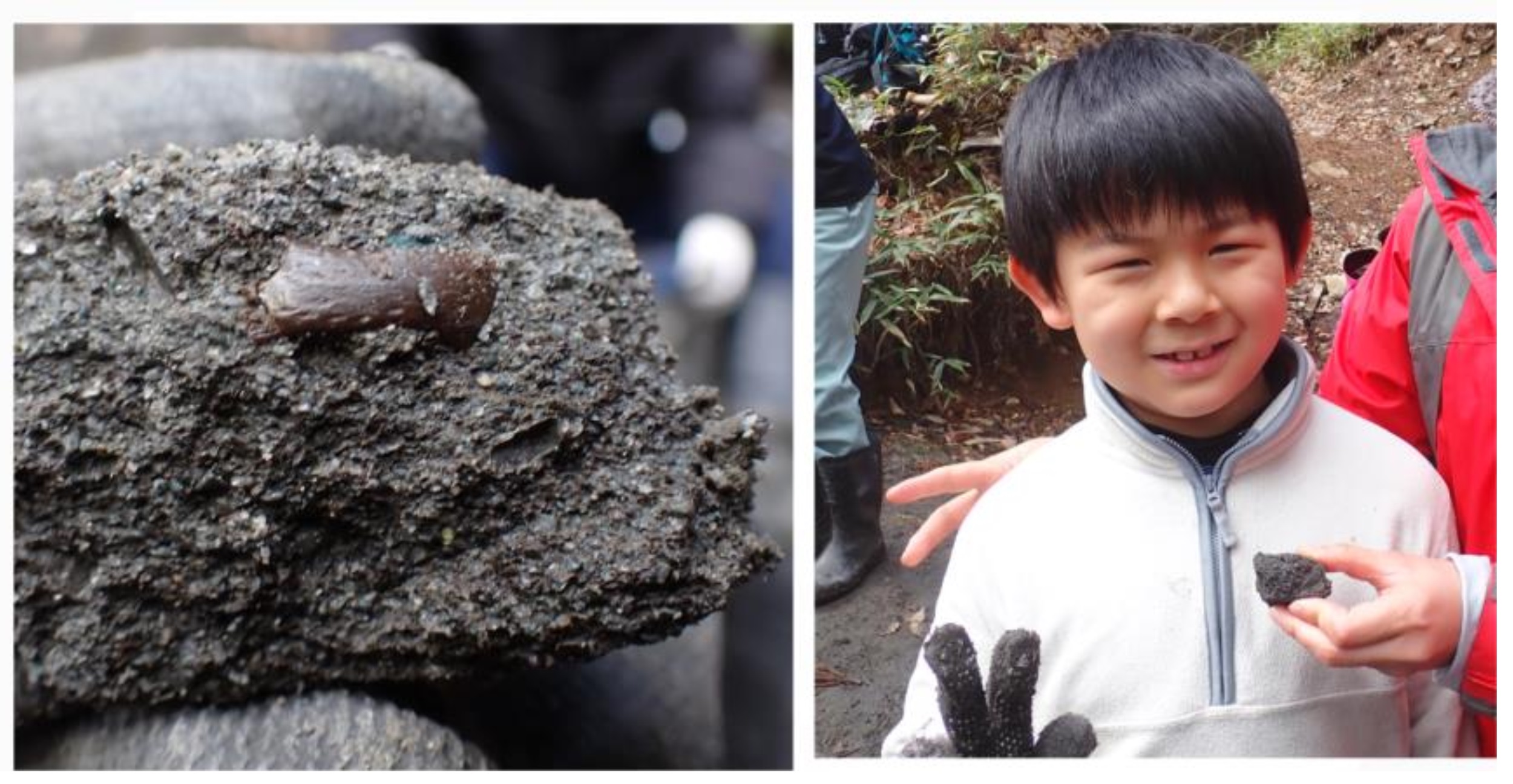
The lower jaw of a Lindholmemys turtle (OSD 4444, Kuji specimen) at the time of discovery and the discoverer, Yu Kubo (March 27, 2023, photo by Hirayama)
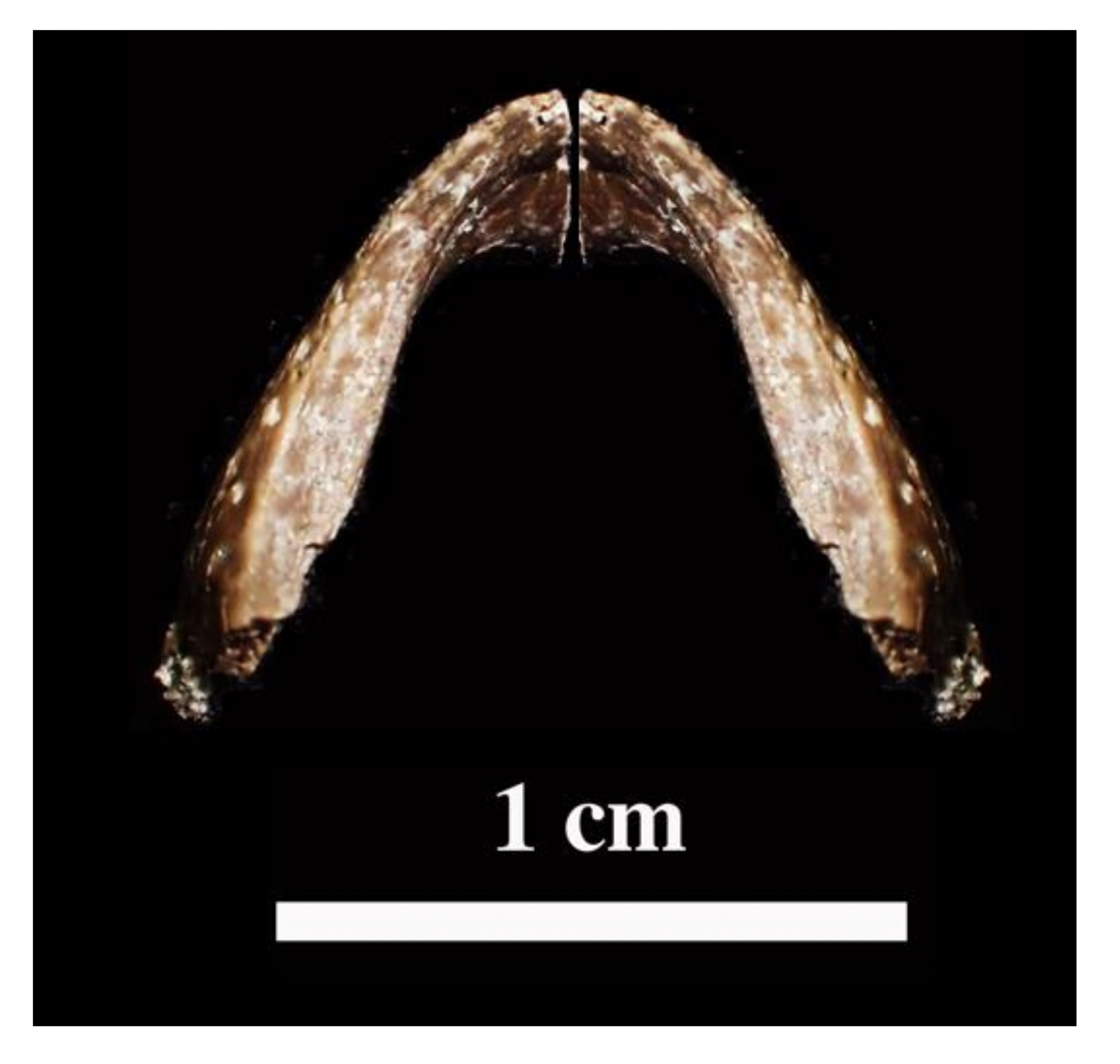
Lower jaw (dorsal view) of a Lindholmemyidae turtle (Kuji specimen) discovered from the Tamagawa Formation of the Kuji Formation
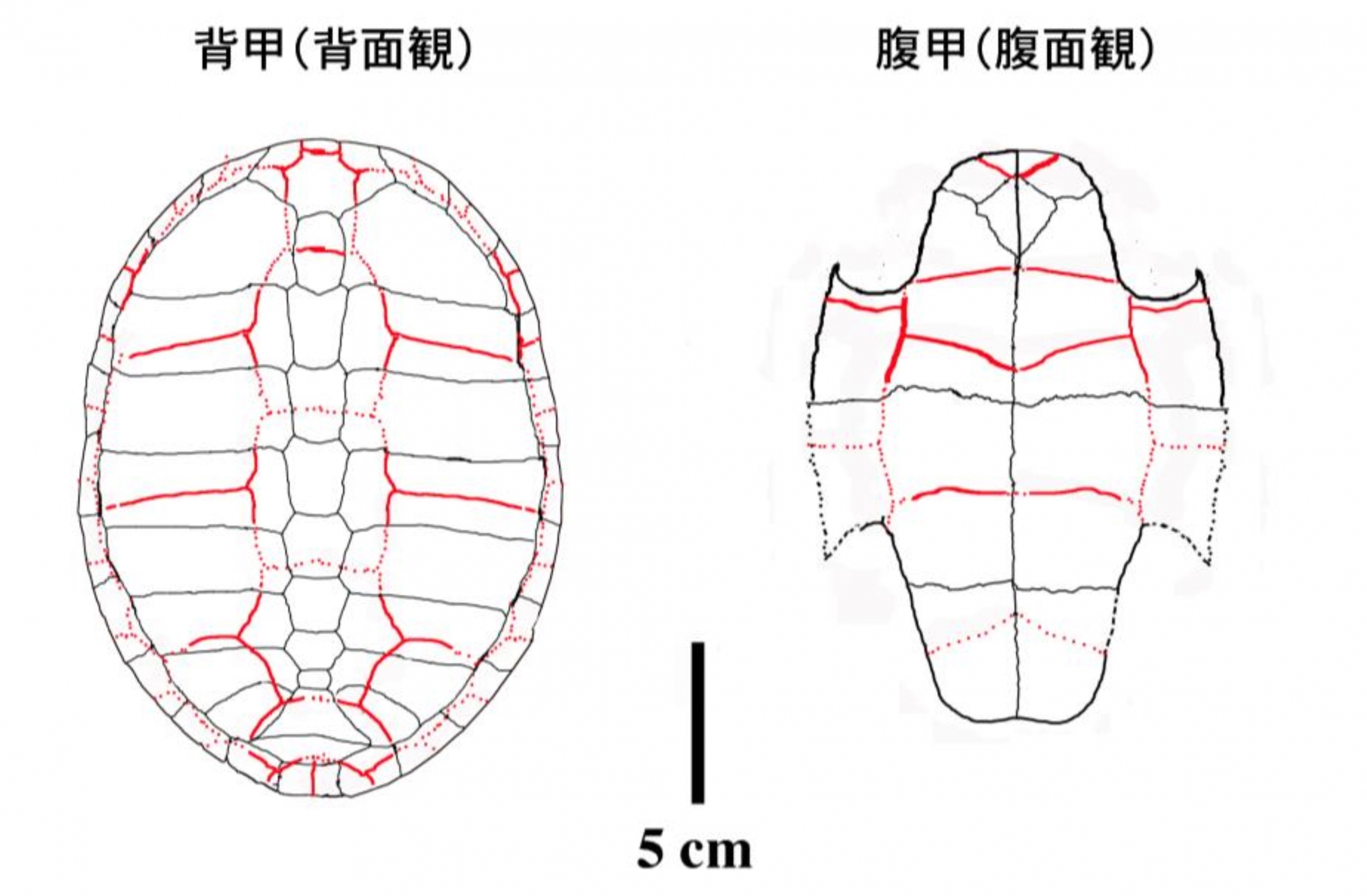
Shell reconstruction of Lindholmemyidae turtles discovered from the Tamagawa Formation of the Kuji Formation: the black line shows the boundary of the bone plate that constitutes the carapace, and the red line shows the boundary of the scales covering the bone plate.
- Links


